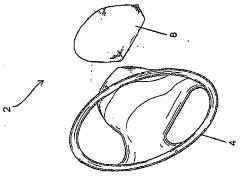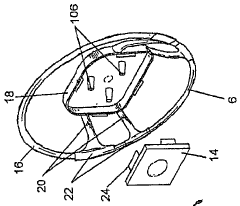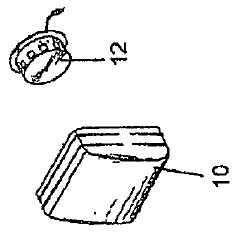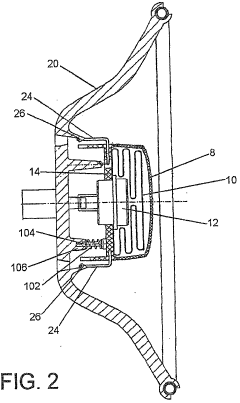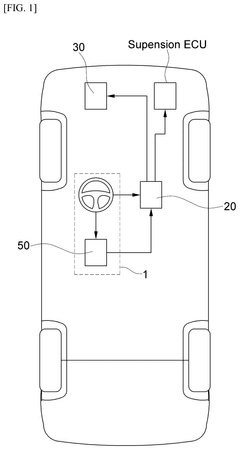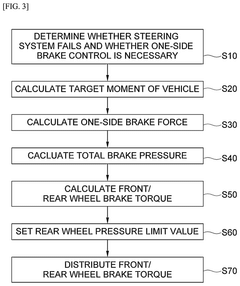Future Trajectory of Steering Wheel Tech in Automotive Industry
JUL 18, 20259 MIN READ
Generate Your Research Report Instantly with AI Agent
Patsnap Eureka helps you evaluate technical feasibility & market potential.
Steering Tech Evolution
The evolution of steering wheel technology in the automotive industry has been marked by significant milestones and innovations over the past century. Initially, steering wheels were simple mechanical devices designed to control the direction of a vehicle. However, as automotive technology advanced, so did the complexity and functionality of steering systems.
In the early 20th century, power steering was introduced, revolutionizing the ease of vehicle control. This hydraulic system reduced the physical effort required to steer, particularly at low speeds or when stationary. The 1950s and 1960s saw widespread adoption of power steering in passenger vehicles, greatly improving driver comfort and control.
The next major leap came with the introduction of electronic power steering (EPS) in the 1990s. EPS replaced hydraulic systems with electric motors, offering more precise control and energy efficiency. This technology also paved the way for advanced driver assistance systems (ADAS) integration, as it allowed for easier implementation of features like lane-keeping assist and self-parking.
The 21st century has witnessed a rapid acceleration in steering wheel technology. Multi-function steering wheels became standard, incorporating controls for audio, cruise control, and communication systems. This integration enhanced driver convenience and reduced distractions by keeping essential controls within easy reach.
Recent years have seen the emergence of steer-by-wire technology, which eliminates the physical connection between the steering wheel and the wheels. This system uses electronic controls and actuators to translate driver input into wheel movement, offering unprecedented flexibility in steering ratio and feedback.
The advent of autonomous driving technology is now pushing steering wheel design into new territories. Concepts like retractable or foldaway steering wheels are being explored for vehicles that can switch between manual and autonomous modes. Some futuristic designs even envision cars without traditional steering wheels, using joysticks or touchscreens for manual control when needed.
Looking ahead, the trajectory of steering wheel technology is likely to be shaped by the continued development of autonomous vehicles and the increasing electrification of automobiles. We can expect to see more advanced haptic feedback systems, augmented reality displays integrated into steering wheels, and even biometric sensors to monitor driver alertness and health. The steering wheel of the future may evolve into a multifunctional interface that serves as a central hub for vehicle control and information display, adapting to the changing needs of drivers in an increasingly automated automotive landscape.
In the early 20th century, power steering was introduced, revolutionizing the ease of vehicle control. This hydraulic system reduced the physical effort required to steer, particularly at low speeds or when stationary. The 1950s and 1960s saw widespread adoption of power steering in passenger vehicles, greatly improving driver comfort and control.
The next major leap came with the introduction of electronic power steering (EPS) in the 1990s. EPS replaced hydraulic systems with electric motors, offering more precise control and energy efficiency. This technology also paved the way for advanced driver assistance systems (ADAS) integration, as it allowed for easier implementation of features like lane-keeping assist and self-parking.
The 21st century has witnessed a rapid acceleration in steering wheel technology. Multi-function steering wheels became standard, incorporating controls for audio, cruise control, and communication systems. This integration enhanced driver convenience and reduced distractions by keeping essential controls within easy reach.
Recent years have seen the emergence of steer-by-wire technology, which eliminates the physical connection between the steering wheel and the wheels. This system uses electronic controls and actuators to translate driver input into wheel movement, offering unprecedented flexibility in steering ratio and feedback.
The advent of autonomous driving technology is now pushing steering wheel design into new territories. Concepts like retractable or foldaway steering wheels are being explored for vehicles that can switch between manual and autonomous modes. Some futuristic designs even envision cars without traditional steering wheels, using joysticks or touchscreens for manual control when needed.
Looking ahead, the trajectory of steering wheel technology is likely to be shaped by the continued development of autonomous vehicles and the increasing electrification of automobiles. We can expect to see more advanced haptic feedback systems, augmented reality displays integrated into steering wheels, and even biometric sensors to monitor driver alertness and health. The steering wheel of the future may evolve into a multifunctional interface that serves as a central hub for vehicle control and information display, adapting to the changing needs of drivers in an increasingly automated automotive landscape.
Market Demand Analysis
The automotive industry is witnessing a significant shift in steering wheel technology, driven by evolving consumer preferences and advancements in vehicle automation. Market demand for innovative steering wheel solutions is on the rise, fueled by the increasing integration of advanced driver assistance systems (ADAS) and the gradual transition towards autonomous vehicles.
Consumer expectations for enhanced safety features and improved driving experiences are reshaping the steering wheel market. There is a growing demand for steering wheels equipped with touch-sensitive controls, haptic feedback, and gesture recognition capabilities. These features allow drivers to interact with various vehicle systems without taking their hands off the wheel, thereby improving safety and convenience.
The market for steering wheels with integrated displays is expanding rapidly. These smart steering wheels provide crucial information directly in the driver's line of sight, reducing distractions and enhancing situational awareness. The demand for such advanced steering wheels is particularly strong in premium and luxury vehicle segments, where consumers are willing to pay a premium for cutting-edge technology.
As vehicle electrification gains momentum, there is an increasing need for steering wheels that complement the unique characteristics of electric vehicles. This includes designs that support regenerative braking controls and energy efficiency management, aligning with the broader trend towards sustainable transportation solutions.
The rise of autonomous driving technology is creating a new market segment for retractable or foldable steering wheels. These innovative designs cater to vehicles that can switch between manual and autonomous modes, allowing for more flexible interior configurations when human input is not required.
Health and wellness features integrated into steering wheels are gaining traction, especially in the wake of global health concerns. Steering wheels with built-in sensors to monitor driver vital signs and detect fatigue or stress levels are seeing increased demand, particularly in commercial vehicle fleets where driver well-being is crucial for safety and operational efficiency.
The market for steering wheel heaters and coolers continues to grow, driven by consumer desire for comfort in all weather conditions. This feature is becoming increasingly standard in mid-range vehicles, expanding beyond its traditional luxury car niche.
Despite the trend towards autonomous vehicles, the steering wheel market is expected to remain robust in the medium term. This is due to the gradual nature of the transition to full autonomy and regulatory requirements mandating human control capabilities in vehicles for the foreseeable future.
The aftermarket for steering wheel upgrades and customization is also experiencing growth, as car enthusiasts seek to personalize their vehicles with unique designs and enhanced functionality. This trend is particularly strong in the sports and performance car segments.
Consumer expectations for enhanced safety features and improved driving experiences are reshaping the steering wheel market. There is a growing demand for steering wheels equipped with touch-sensitive controls, haptic feedback, and gesture recognition capabilities. These features allow drivers to interact with various vehicle systems without taking their hands off the wheel, thereby improving safety and convenience.
The market for steering wheels with integrated displays is expanding rapidly. These smart steering wheels provide crucial information directly in the driver's line of sight, reducing distractions and enhancing situational awareness. The demand for such advanced steering wheels is particularly strong in premium and luxury vehicle segments, where consumers are willing to pay a premium for cutting-edge technology.
As vehicle electrification gains momentum, there is an increasing need for steering wheels that complement the unique characteristics of electric vehicles. This includes designs that support regenerative braking controls and energy efficiency management, aligning with the broader trend towards sustainable transportation solutions.
The rise of autonomous driving technology is creating a new market segment for retractable or foldable steering wheels. These innovative designs cater to vehicles that can switch between manual and autonomous modes, allowing for more flexible interior configurations when human input is not required.
Health and wellness features integrated into steering wheels are gaining traction, especially in the wake of global health concerns. Steering wheels with built-in sensors to monitor driver vital signs and detect fatigue or stress levels are seeing increased demand, particularly in commercial vehicle fleets where driver well-being is crucial for safety and operational efficiency.
The market for steering wheel heaters and coolers continues to grow, driven by consumer desire for comfort in all weather conditions. This feature is becoming increasingly standard in mid-range vehicles, expanding beyond its traditional luxury car niche.
Despite the trend towards autonomous vehicles, the steering wheel market is expected to remain robust in the medium term. This is due to the gradual nature of the transition to full autonomy and regulatory requirements mandating human control capabilities in vehicles for the foreseeable future.
The aftermarket for steering wheel upgrades and customization is also experiencing growth, as car enthusiasts seek to personalize their vehicles with unique designs and enhanced functionality. This trend is particularly strong in the sports and performance car segments.
Current Challenges
The steering wheel, a fundamental component of vehicle control, faces several challenges in the rapidly evolving automotive industry. One of the primary issues is the integration of advanced driver assistance systems (ADAS) and autonomous driving technologies. As vehicles become more automated, the traditional role of the steering wheel is being questioned, leading to a need for redesign and reimagining of its functionality.
Safety concerns present another significant challenge. With the increasing complexity of in-vehicle systems, there is a growing risk of driver distraction. Steering wheel designers must find ways to incorporate new features and controls without compromising driver attention or vehicle safety. This includes the integration of haptic feedback systems and adaptive controls that can adjust based on driving conditions or driver preferences.
The transition towards electric and hybrid vehicles also poses challenges for steering wheel technology. These vehicles often require different power steering systems, which can affect the feel and responsiveness of the steering wheel. Engineers must develop solutions that maintain or enhance steering precision and driver feedback while accommodating the unique characteristics of electric powertrains.
Ergonomics and user experience represent another area of concern. As vehicles become more technologically advanced, there is a need to balance the incorporation of new features with user-friendly designs. This includes considerations for different body types, driving styles, and accessibility needs, ensuring that steering wheels remain comfortable and intuitive for all users.
The push for sustainability in the automotive industry also impacts steering wheel technology. Manufacturers are under pressure to use eco-friendly materials and production processes, which can affect the cost and performance of steering wheel components. Finding sustainable alternatives that meet safety and durability standards remains a significant challenge.
Regulatory compliance adds another layer of complexity. As automotive regulations evolve, particularly concerning autonomous driving and safety features, steering wheel designs must adapt to meet new standards. This often requires innovative solutions that can be costly and time-consuming to develop and implement.
Lastly, the cost factor cannot be overlooked. As steering wheels become more technologically advanced, incorporating features like touch-sensitive controls, biometric sensors, and shape-shifting capabilities, the manufacturing costs increase significantly. Balancing these advanced features with affordability, especially for mass-market vehicles, presents a considerable challenge for automotive manufacturers and suppliers.
Safety concerns present another significant challenge. With the increasing complexity of in-vehicle systems, there is a growing risk of driver distraction. Steering wheel designers must find ways to incorporate new features and controls without compromising driver attention or vehicle safety. This includes the integration of haptic feedback systems and adaptive controls that can adjust based on driving conditions or driver preferences.
The transition towards electric and hybrid vehicles also poses challenges for steering wheel technology. These vehicles often require different power steering systems, which can affect the feel and responsiveness of the steering wheel. Engineers must develop solutions that maintain or enhance steering precision and driver feedback while accommodating the unique characteristics of electric powertrains.
Ergonomics and user experience represent another area of concern. As vehicles become more technologically advanced, there is a need to balance the incorporation of new features with user-friendly designs. This includes considerations for different body types, driving styles, and accessibility needs, ensuring that steering wheels remain comfortable and intuitive for all users.
The push for sustainability in the automotive industry also impacts steering wheel technology. Manufacturers are under pressure to use eco-friendly materials and production processes, which can affect the cost and performance of steering wheel components. Finding sustainable alternatives that meet safety and durability standards remains a significant challenge.
Regulatory compliance adds another layer of complexity. As automotive regulations evolve, particularly concerning autonomous driving and safety features, steering wheel designs must adapt to meet new standards. This often requires innovative solutions that can be costly and time-consuming to develop and implement.
Lastly, the cost factor cannot be overlooked. As steering wheels become more technologically advanced, incorporating features like touch-sensitive controls, biometric sensors, and shape-shifting capabilities, the manufacturing costs increase significantly. Balancing these advanced features with affordability, especially for mass-market vehicles, presents a considerable challenge for automotive manufacturers and suppliers.
Existing Solutions
01 Steering wheel design and ergonomics
Innovations in steering wheel design focus on improving ergonomics and driver comfort. This includes optimizing the shape, size, and grip of the steering wheel to reduce fatigue during long drives and enhance control. Advanced materials and manufacturing techniques are employed to create steering wheels that are both functional and aesthetically pleasing.- Steering wheel design and ergonomics: Innovations in steering wheel design focus on improving ergonomics and driver comfort. This includes optimizing the shape, size, and grip of the steering wheel to reduce fatigue during long drives and enhance control. Advanced materials and manufacturing techniques are employed to create steering wheels that are both functional and aesthetically pleasing.
- Integration of controls and displays: Modern steering wheels incorporate various controls and displays to enhance driver convenience and safety. These may include buttons for audio control, cruise control, and phone operations, as well as small screens or head-up displays for providing important vehicle information without requiring the driver to look away from the road.
- Steering wheel heating and cooling systems: To improve comfort in various weather conditions, steering wheels are being equipped with heating and cooling systems. These systems can quickly adjust the temperature of the steering wheel surface, providing a more pleasant driving experience in extreme hot or cold environments.
- Advanced safety features in steering wheels: Steering wheels are being developed with advanced safety features such as airbag integration, impact-absorbing materials, and sensors for detecting driver grip and alertness. These innovations aim to reduce injuries in the event of a collision and improve overall vehicle safety.
- Adjustable and customizable steering wheels: Innovations in steering wheel adjustability and customization allow drivers to tailor the position, shape, and functionality of the steering wheel to their preferences. This includes telescoping and tilting mechanisms, as well as modular designs that enable easy swapping of steering wheel components or entire wheels.
02 Integration of controls and displays
Modern steering wheels often incorporate various controls and displays to enhance driver convenience and safety. This can include buttons for audio control, cruise control, and voice commands, as well as small screens or heads-up displays for providing important information without requiring the driver to look away from the road.Expand Specific Solutions03 Steering wheel heating and cooling systems
To improve comfort in various weather conditions, some steering wheels are equipped with heating and cooling systems. These systems can quickly warm up the steering wheel in cold weather or keep it cool in hot conditions, enhancing the overall driving experience and potentially improving safety by ensuring the driver maintains a good grip.Expand Specific Solutions04 Adjustable and collapsible steering mechanisms
Advancements in steering wheel technology include adjustable and collapsible mechanisms. These allow for customization of the steering wheel position to suit different drivers and can also improve safety by collapsing in the event of a collision, reducing the risk of injury to the driver.Expand Specific Solutions05 Smart steering wheels with biometric sensors
Emerging technologies are introducing smart steering wheels equipped with biometric sensors. These can monitor the driver's vital signs, detect drowsiness or distraction, and even potentially identify the driver for security purposes. Such innovations aim to enhance both safety and personalization in driving experiences.Expand Specific Solutions
Key Industry Players
The steering wheel technology in the automotive industry is currently in a transitional phase, with the market poised for significant growth as autonomous driving technologies advance. The global market for steering systems is expected to expand substantially in the coming years, driven by increasing demand for electric power steering and steer-by-wire systems. Companies like Autoliv, GM Global Technology, Nissan, and BMW are at the forefront of developing advanced steering technologies, with varying levels of technological maturity. While traditional players like Bosch and ZF dominate the market, newer entrants such as Chassis Autonomy and Polestar are pushing innovation in electric and autonomous steering solutions. The competitive landscape is intensifying as automakers and suppliers race to develop and integrate next-generation steering systems for future vehicles.
Nissan Motor Co., Ltd.
Technical Solution: Nissan is advancing steering wheel technology through its "ProPILOT" system and autonomous driving research. The company has developed a steer-by-wire system called "Direct Adaptive Steering" that eliminates the mechanical connection between the steering wheel and tires, allowing for more precise control and reduced vibration[13]. Nissan's steering wheels incorporate capacitive touch sensors for detecting driver grip and attentiveness. The company is also exploring retractable steering wheel designs for use in autonomous driving modes[14]. Additionally, Nissan is researching brain-to-vehicle (B2V) technology that could potentially allow the steering wheel to respond to the driver's thoughts, enhancing reaction times and driving experience[15].
Strengths: Advanced steer-by-wire technology, innovative B2V research, and integration with autonomous driving systems. Weaknesses: Potential for driver discomfort with non-traditional steering feel and the need for extensive testing and regulatory approval for novel technologies.
Bayerische Motoren Werke AG
Technical Solution: BMW is advancing steering wheel technology through its "iDrive" system and autonomous driving research. The company has developed a polygonal steering wheel design that incorporates touch-sensitive areas and gesture controls[7]. This allows for more intuitive interaction with vehicle systems without taking hands off the wheel. BMW is also exploring retractable steering wheel concepts for use in autonomous vehicles, where the wheel can disappear into the dashboard when not needed[8]. The company's steering wheels feature integrated LED light strips that provide visual cues for driver assistance systems and autonomous driving modes. Additionally, BMW is researching haptic feedback systems that can convey road conditions and navigation information through the steering wheel[9].
Strengths: Innovative control interfaces, adaptable designs for autonomous driving, and advanced haptic feedback systems. Weaknesses: Potential for driver distraction with complex interfaces and the need for driver adaptation to new control methods.
Innovative Steering Tech
Steering wheel and method of manufacturing a steering wheel
PatentInactiveDE112006000789T5
Innovation
- A method involving a mold with offset attachment points to centralize the outer rim during die casting, using a tubular insert made of steel and a die-cast material like aluminum or magnesium for the spokes and hub, ensuring precise alignment and improved structural integrity.
One-side brake control system and control method of distributing torques between front and rear wheels to perform one-side brake
PatentPendingUS20240308585A1
Innovation
- A one-side brake control system and method that distributes torque between the front and rear wheels, using a target steering angle input unit, integrated ECU, and braking ECU to calculate and apply appropriate brake torques to the wheels, allowing for stable emergency steering and preventing wheel slip by limiting rear wheel brake pressure.
Regulatory Framework
The regulatory framework surrounding steering wheel technology in the automotive industry is evolving rapidly to keep pace with technological advancements and changing safety requirements. Governments and regulatory bodies worldwide are actively updating their guidelines to address the challenges posed by emerging technologies such as autonomous driving systems and advanced driver assistance features.
In many jurisdictions, current regulations mandate the presence of a steering wheel in all road-going vehicles. However, as the industry moves towards higher levels of automation, regulatory bodies are beginning to reassess these requirements. For instance, the National Highway Traffic Safety Administration (NHTSA) in the United States has initiated discussions on modifying Federal Motor Vehicle Safety Standards (FMVSS) to accommodate vehicles without traditional steering wheels.
The European Union, through its United Nations Economic Commission for Europe (UNECE), has also been proactive in developing regulations for automated driving systems. The UNECE has introduced a new regulation on Automated Lane Keeping Systems (ALKS), which allows for hands-off driving in certain conditions. This regulation sets a precedent for future amendments that may impact steering wheel requirements.
Safety standards are a crucial aspect of the regulatory framework. As steering wheel technology advances, regulators are focusing on ensuring that new systems meet or exceed the safety levels of traditional steering mechanisms. This includes requirements for redundancy, fail-safe mechanisms, and cybersecurity measures to protect against potential hacking or system failures.
The transition to drive-by-wire systems and steer-by-wire technologies is prompting regulators to develop new testing and certification procedures. These procedures aim to verify the reliability and performance of electronic steering systems under various operating conditions and potential failure scenarios.
Regulatory bodies are also addressing the human factors associated with advanced steering technologies. This includes guidelines for driver engagement, takeover requests in semi-autonomous systems, and the design of human-machine interfaces. The goal is to ensure that drivers can safely interact with and override automated steering functions when necessary.
As the industry moves towards higher levels of autonomy, regulators are grappling with the concept of shared responsibility between human drivers and automated systems. This has led to ongoing discussions about liability frameworks and insurance regulations, which will significantly impact the future development and deployment of advanced steering technologies.
In many jurisdictions, current regulations mandate the presence of a steering wheel in all road-going vehicles. However, as the industry moves towards higher levels of automation, regulatory bodies are beginning to reassess these requirements. For instance, the National Highway Traffic Safety Administration (NHTSA) in the United States has initiated discussions on modifying Federal Motor Vehicle Safety Standards (FMVSS) to accommodate vehicles without traditional steering wheels.
The European Union, through its United Nations Economic Commission for Europe (UNECE), has also been proactive in developing regulations for automated driving systems. The UNECE has introduced a new regulation on Automated Lane Keeping Systems (ALKS), which allows for hands-off driving in certain conditions. This regulation sets a precedent for future amendments that may impact steering wheel requirements.
Safety standards are a crucial aspect of the regulatory framework. As steering wheel technology advances, regulators are focusing on ensuring that new systems meet or exceed the safety levels of traditional steering mechanisms. This includes requirements for redundancy, fail-safe mechanisms, and cybersecurity measures to protect against potential hacking or system failures.
The transition to drive-by-wire systems and steer-by-wire technologies is prompting regulators to develop new testing and certification procedures. These procedures aim to verify the reliability and performance of electronic steering systems under various operating conditions and potential failure scenarios.
Regulatory bodies are also addressing the human factors associated with advanced steering technologies. This includes guidelines for driver engagement, takeover requests in semi-autonomous systems, and the design of human-machine interfaces. The goal is to ensure that drivers can safely interact with and override automated steering functions when necessary.
As the industry moves towards higher levels of autonomy, regulators are grappling with the concept of shared responsibility between human drivers and automated systems. This has led to ongoing discussions about liability frameworks and insurance regulations, which will significantly impact the future development and deployment of advanced steering technologies.
Human-Machine Interface
The evolution of steering wheel technology in the automotive industry is closely intertwined with advancements in human-machine interface (HMI) design. As vehicles become more sophisticated and autonomous, the steering wheel is transforming from a simple control device into a complex interface that facilitates seamless interaction between the driver and the vehicle's systems.
Modern steering wheels are increasingly equipped with touch-sensitive surfaces and haptic feedback mechanisms. These features allow drivers to control various vehicle functions without taking their hands off the wheel, enhancing safety and convenience. Capacitive touch sensors embedded in the steering wheel rim enable gesture controls, allowing drivers to adjust audio volume, change tracks, or accept phone calls with simple swipes or taps.
Voice recognition technology is being integrated into steering wheel controls, enabling drivers to issue commands and receive information through natural language interactions. This hands-free approach minimizes distractions and allows for more intuitive control of vehicle systems. Additionally, steering wheels are incorporating biometric sensors to monitor driver health and alertness, providing valuable data for advanced driver assistance systems (ADAS).
The advent of steer-by-wire technology is revolutionizing the physical connection between the steering wheel and the vehicle's wheels. This electronic system allows for greater flexibility in steering wheel design and placement, potentially leading to more ergonomic and customizable interfaces. It also enables the implementation of variable steering ratios and feedback, adapting to different driving conditions and preferences.
As vehicles transition towards higher levels of autonomy, the steering wheel is evolving to accommodate both manual and autonomous driving modes. Retractable steering wheels that can disappear into the dashboard during autonomous operation are being developed, creating a more spacious and versatile cabin environment. When manual control is required, these steering wheels can quickly deploy, seamlessly transitioning between driving modes.
Augmented reality (AR) displays integrated into or projected onto the steering wheel are emerging as a promising technology. These displays can provide real-time navigation information, vehicle status updates, and warnings directly in the driver's line of sight, reducing the need to look away from the road. This technology has the potential to greatly enhance situational awareness and driving safety.
The future of steering wheel technology will likely see further integration with other vehicle systems, creating a more holistic and intuitive driving experience. As artificial intelligence and machine learning capabilities advance, steering wheels may become more predictive and adaptive, anticipating driver needs and preferences. This could lead to personalized interfaces that adjust based on individual driving styles, habits, and environmental conditions.
Modern steering wheels are increasingly equipped with touch-sensitive surfaces and haptic feedback mechanisms. These features allow drivers to control various vehicle functions without taking their hands off the wheel, enhancing safety and convenience. Capacitive touch sensors embedded in the steering wheel rim enable gesture controls, allowing drivers to adjust audio volume, change tracks, or accept phone calls with simple swipes or taps.
Voice recognition technology is being integrated into steering wheel controls, enabling drivers to issue commands and receive information through natural language interactions. This hands-free approach minimizes distractions and allows for more intuitive control of vehicle systems. Additionally, steering wheels are incorporating biometric sensors to monitor driver health and alertness, providing valuable data for advanced driver assistance systems (ADAS).
The advent of steer-by-wire technology is revolutionizing the physical connection between the steering wheel and the vehicle's wheels. This electronic system allows for greater flexibility in steering wheel design and placement, potentially leading to more ergonomic and customizable interfaces. It also enables the implementation of variable steering ratios and feedback, adapting to different driving conditions and preferences.
As vehicles transition towards higher levels of autonomy, the steering wheel is evolving to accommodate both manual and autonomous driving modes. Retractable steering wheels that can disappear into the dashboard during autonomous operation are being developed, creating a more spacious and versatile cabin environment. When manual control is required, these steering wheels can quickly deploy, seamlessly transitioning between driving modes.
Augmented reality (AR) displays integrated into or projected onto the steering wheel are emerging as a promising technology. These displays can provide real-time navigation information, vehicle status updates, and warnings directly in the driver's line of sight, reducing the need to look away from the road. This technology has the potential to greatly enhance situational awareness and driving safety.
The future of steering wheel technology will likely see further integration with other vehicle systems, creating a more holistic and intuitive driving experience. As artificial intelligence and machine learning capabilities advance, steering wheels may become more predictive and adaptive, anticipating driver needs and preferences. This could lead to personalized interfaces that adjust based on individual driving styles, habits, and environmental conditions.
Unlock deeper insights with Patsnap Eureka Quick Research — get a full tech report to explore trends and direct your research. Try now!
Generate Your Research Report Instantly with AI Agent
Supercharge your innovation with Patsnap Eureka AI Agent Platform!
